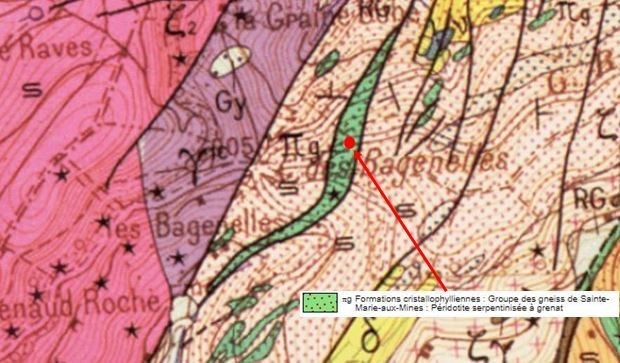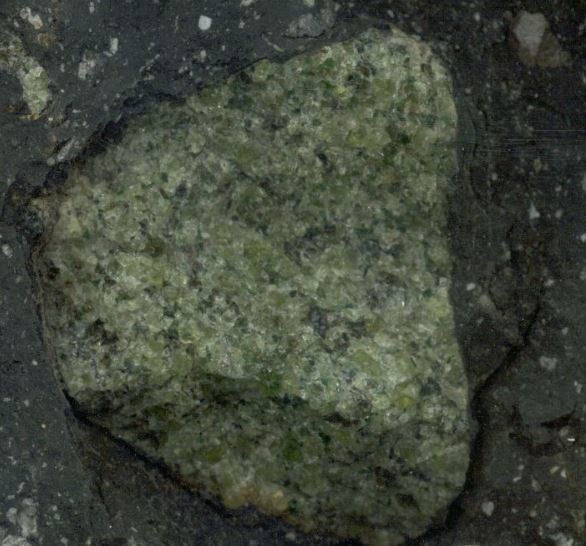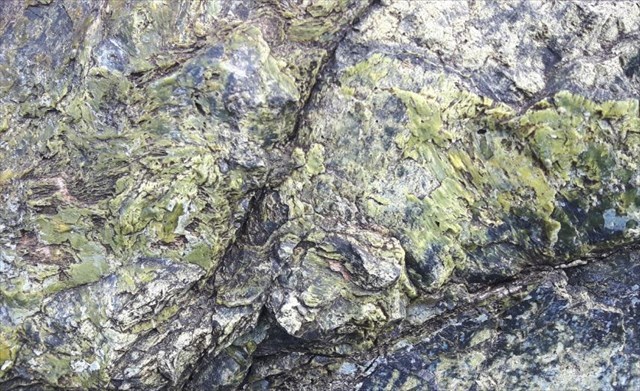
La Earthcache / The Earthcache
Parce qu'il n'y a pas que le grès vosgien en Alsace...
Cette petite série de caches géologiques a pour objectif de permettre la découverte sur le terrain de la richesse géologique du Centre Alsace et d'avoir un court aperçu de son histoire tumultueuse qui a aboutit à la mise en place de cette diversité de roches et des phénomènes tectoniques majeures dont cette région a été l'objet au travers des Ages.
Ce cinquième épisode va partir à la découverte d'une formation rocheuse atypique à la surface terrestre, existant nativement dans les profondeurs du manteau supérieur, la péridotite.
► Contexte géologique local
L'étude de la région du Haycot permet de découvrir un ensemble de formations particulières, assez rares à la surface de la terre.

On peut voir sous la forme d'affleurement en petites massifs ou écailles la formation "πg. Péridotites serpentinisées à grenat."
Ces corps de péridotites apparaissent sous la forme de copeaux allongés de taille variable, associés à un massif de granulites. La granulite est une roche métamorphique très grenue, avec des gros grains.
Comment des formations du manteau, les péridotites, se sont-elles retrouvées à l'air libre liées à des formations crustales ?
► Nature des formations mantelliques
~ De la péridotite...
La péridotite est une roche constituée principalement de cristaux d'olivine et de pyroxènes.
Elle constitue la majeure partie du manteau terrestre ; elle en est la roche mère.
Ultramafiques (ou ultrabasiques), de structure grenue, les péridotites sont principalement constituées d'olivine associée à d'autres silicates ferro-magnésiens, essentiellement des pyroxènes.
Cela lui donne une couleur sombre à noire selon la composition géologique.

Il s'agit donc une roche primaire magmatique, un protolithe, directement issu de la solidification du magma du manteau supérieur.
La péridotite peut se transformer en une roche secondaire sous l'effet de la chaleur et d'une hydratation, c'est le métamorphisme hydrothermal.
Ce métamorphisme hydrothermal se déroule à faible pression, à faible température (quelques centaines de degrés) et en présence de grande quantité d'eau.
Le processus se fait à l'état solide.
L’altération de tous les minéraux lui donne des couleurs bleutées, verdâtres avec un aspect lustré, dues à la serpentine.
~ ... à la serpentine
La serpentinite est une roche métamorphique donc secondaire, fruit de la transformation d'un protolithe de péridotite sous des conditions de pression et de température particulière.
C'est un type de roche magmatique métamorphisé relative rare.
Il s'agit d'une roche associant des couleurs bleues et verdâtres. Elle est surtout constituée (plus de 75 %) d'antigorite (phyllosilicate magnésien). Son aspect est beaucoup moins grenue que son protolithe, et présente une caractère massif et fondue propre à une roche métamorphique Elle présente par ailleurs des macro-cristaux centimétriques d'inclusions verdâtres (forme porphyroide).
Ces cristaux sont de la serpentine, un minéral tendre, vert, riche en aluminium (silicate d'aluminium hydraté) qui est issue de la transformation de l'olivine et du piroxène avec l'eau lors son exposition à la surface de la terre.

► Formation et transformation
Initialement , la formation de péridotite s'est formée à 150 km de profondeur, sous la forme de péridotites à grenat, initialement équilibrées à 5 Gpa de pression et 1100-1200°C de température.
Une délamination de la croûte continentale dans le manteau à permis l'incorporation d’écailles péridotitiques dans un encaissant de granulites felsiques.
Ces écailles mantelliques sous continentales incorporée à la base de la croûte continentale sont ensuite remontées vers des couches moins profondes lors de l'orogenèse hercynienne (on parle de prisme orogénique).
Cette remontée de la croûte et des écailles a été rapide : 4 mm par an.
La chaîne hercynienne antérieure à la chaîne vosgienne a ensuite connu un érosion intense, ramenant à la surface ces formations qui constituaient les racines de cette chaîne de montagnes des temps anciens.
Because there is not only the Vosges sandstone in Alsace ...
This small series of geological caches is intended to allow the discovery on the ground of the geological wealth of the Alsace Center and to have a brief overview of its tumultuous history which has led to the establishment of this diversity of rocks and phenomena major tectonics of which this region has been the object through the Ages.
This fifth episode will begin to discover an atypical rock formation on the Earth's surface, existing natively in the depths of the upper mantle, peridotite.
► Local geological context
The study of the Haycot region reveals a set of particular formations, quite rare on the surface of the earth.
The formation "πg serpentinized peridotites with garnet" can be seen in the form of outcrops in small masses or scales.
These bodies of peridotites appear in the form of elongated chips of variable size, associated with a mass of granulites. Granulite is a very granular metamorphic rock with coarse grains.
How did mantle formations, the peridotites, find themselves in the open air related to crustal formations?
► ► Nature of mantle formations
~ From Peridotite ...
Peridotite is a rock composed mainly of olivine crystals and pyroxenes.
It constitutes the major part of the terrestrial mantle; she is the rock mother.
Ultramafic (or ultramafic), granular structure, peridotites are mainly composed of olivine associated with other ferro-magnesian silicates, mainly pyroxenes.
This gives it a dark to black color depending on the geological composition.
It is therefore a magmatic primary rock, a protolith, directly resulting from the solidification of the magma of the upper mantle.
Peridotite can be transformed into a secondary rock under the effect of heat and hydration, it is hydrothermal metamorphism. This hydrothermal metamorphism occurs at low pressure, at low temperature (a few hundred degrees) and in the presence of large amounts of water.
The process is in the solid state.
The alteration of all the minerals gives it bluish, greenish colors with a lustrous aspect, due to the serpentine.
~ ... to Serpentine
Serpentinite is a secondary metamorphic rock, the result of the transformation of a protolith of peridotite under conditions of pressure and temperature.
It is a relatively rare metamorphosed magmatic rock type.
It is a rock combining blue and greenish colors. It is mainly constituted (more than 75%) antigorite (magnesian phyllosilicate). Its appearance is much less granular than its protolith, and has a massive and melted character peculiar to a metamorphic rock It also has centimetric macro-crystals of greenish inclusions (porphyroid form).
These crystals are serpentine, a soft, green, aluminum-rich mineral (hydrated aluminum silicate) that is derived from the transformation of olivine and piroxene with water when exposed to the earth's surface.
► Formation and transformation context
Initially, the formation of peridotite formed at 150 km depth, in the form of garnet peridotites, initially balanced at 5 Gpa pressure and 1100-1200 ° C temperature.
Delamination of the continental crust in the mantle allowed the incorporation of peridotitic scales into a host of felsic granulites.
These sub-continental mantle scales incorporated at the base of the continental crust are then raised to shallower layers during the Hercynian orogeny (orogenic prism).
This rise of crust and scales was rapid: 4 mm per year.
The Hercynian chain anterior to the Vosges chain then experienced intense erosion, bringing to the surface these formations that formed the roots of this mountain range of ancient times.
► Sources bibliographiques / Bibliographical sources
Les Questions / The Questions
La lecture attentive du descriptif de la cache, ainsi qu'une observation des éléments de terrain et un peu de déduction sont normalement suffisants pour répondre aux questions de cette EarthCache.
A careful reading of the description of the cache, as well as observation of terrain features and some deduction is usually sufficient to answer questions of this EarthCache.
Questions pour valider :"Péridotites au Haïcot"
Questions to validate: "Peridotites in Haïcot"
Après vous être garé au PK indiqué, remontez le sentier sur quelques mètres jusqu'à un affleurement côté droit du chemin (photo WP1).
After parking at the designated KP, walk up the trail for a few meters to an outcrop on the right side of the path (photo WP1).

- Question 1 : Décrire la caractéristique globale de la roche (couleur, présence de grains, aspect massif ou pas). Est-ce de la granulite ? Justifier votre réponse.
- Question 1 : Describe the overall characteristic of the rock (color, presence of grains, massive appearance or not). Is it granulite? Justify your answer.
- Question 2 : Des minéraux semblent se détacher à la surface de la roche sous la zone rouge. Qu'ont-ils de particulier ? De quel minéral s'agit-il ?
- Question 2 : Minerals appear to come off the surface of the rock beneath the red zone. What do they have of particular? What mineral is it?
- Question 3 : Quelle est la taille moyenne de ces cristaux à la surface ? De cette taille, déduisez en un qualificatif.
- Question 3 : What is the average size of these crystals on the surface? From this size, deduce in a qualifier.
Vous pouvez vous loguer sans attendre notre confirmation,
mais vous devez nous envoyer les réponses en même temps soit par mail via notre profil (
fafahakkai), soit via la messagerie geocaching.com (Message Center).
S'il y a des problèmes avec vos réponses nous vous en ferons part.
Les logs enregistrés sans réponses seront supprimés.Une photo de vous ou de votre GPS sur le site (mais sans les zones d'observation) est la bienvenue, mais n'est pas obligatoire.
You can log this cache without waiting for our confirmation, but you must send us the answers at the same time, by e-mail via our profile (fafahakkai) or by the system of Message Center of geocaching.com.
If there is a problem with your answers we will notify you. The logs recorded without answers will be deleted.
A photo of you or your GPS in Black & White on the site is welcome, but not mandatory.
Rappel concernant les « Earthcaches »: Il n'y a pas de conteneur à rechercher ni de logbook à renseigner. Il suffit de se rendre sur les lieux, de répondre aux questions ci-dessus et de nous renvoyer les réponses.
Reminder concerning "Earthcaches": there is neither a container to look for nor a logbook to sign. One need only go to the location, answer to the differents questions and send us the answers.